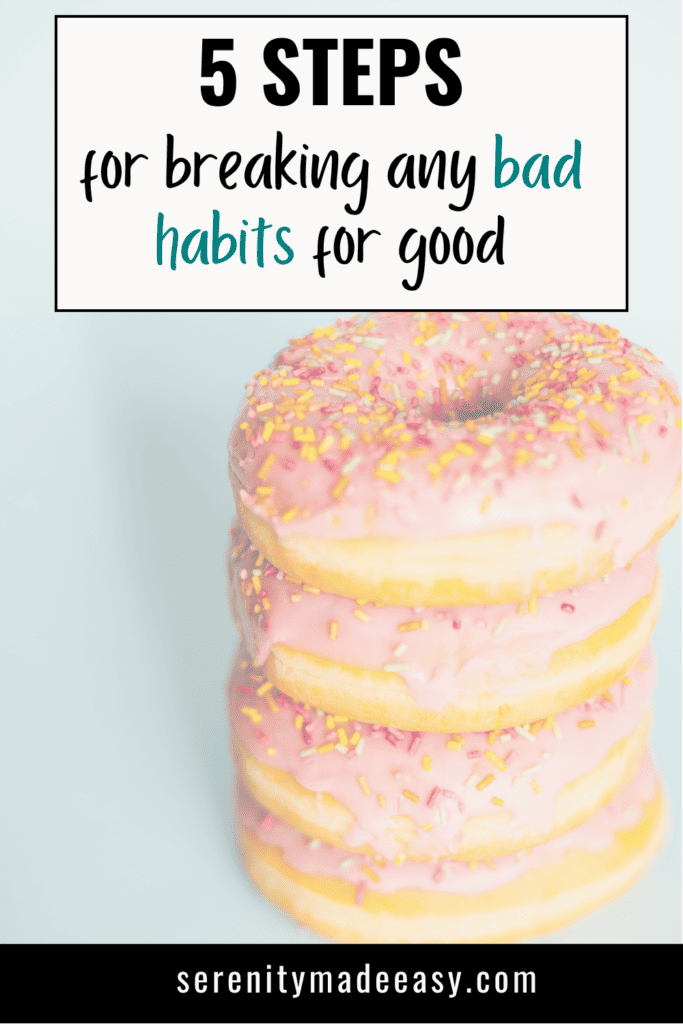This post may contain affiliate links. If you click one and make a purchase, I earn a small commission at no extra cost to you. It helps support the site so I can continue to offer great content to you!

On a daily basis, you may find yourself carrying out actions without even realizing it. In fact, approximately 40% of your daily activities are automatic responses to your surroundings. These unintentional responses are known as habits and can be challenging to modify because they are deeply ingrained in our behavior. In this article, we will explore how to break a habit in a sustainable manner.
What habit should you stop?
The question of what is a good or a bad habit is deeply individualized. Furthermore, it depends on what your personal goals are.
For example, if I wish to take part in a triathlon this year, I’ll need to make some changes to my workout routine. Going to the gym once a week on Fridays after work won’t be enough. I’ll have to increase the frequency of my training sessions and mix up the types of exercises I do.
Along the same lines, if I work daily at 8 am, my 2 am bedtime is likely a bad habit that is not supportive of being my best self. However, if I work the second shift and start at noon, this routine may be quite appropriate for me.
To understand which habits you want to stop, you must first analyze your current situation.
Why is it hard to stop a habit?
Having a bad habit can hinder your ability to be the best version of yourself. Despite acknowledging that the habit is not conducive to achieving your goals and aspirations, breaking it can be challenging.
Did you know that doing routine activities can trigger the release of dopamine in your body? This hormone is often referred to as the “feel-good” chemical, and it can give you a sense of happiness and comfort. By sticking to your habits (good or bad), you can maintain a sense of calm and predictability in your life.
When you try to stop a habit without a proper system, your body feels challenged and stressed. After a few days of trying, most of us quit and go back to what feels good.

How to stop a habit?
With all this said, many habits are bad for us. Wanting to break them is smart and honorable. So how to stop a habit?
Step 1 – The why
There are two crucial considerations regarding the habit: the reason why you developed it and the reason why you want to quit it.
Bad habits are created for several factors. They can be a response to stressful moments, a tendency for laziness, a desire to fit in, or even sheer boredom. Maybe you bite your fingernails to cope with stressful situations. Or perhaps, you eat unhealthy fast food too many times each week because you don’t want to take the time to prepare food.
Understanding the root cause of your bad habits is crucial.
Additionally, understanding why you want to stop a particular habit is pivotal to your success. This rationale will be the anchor you will return to when you are struggling. To continue with our examples, your reason to want to stop biting your nails may be that you are embarrassed by your hands in social situations. And you know that junk food is likely a contributor to your recently diagnosed high cholesterol which could hinder your longevity.
Make your why visible. Write it on a Post-it and stick on on your mirror, save it as your screen lock on your phone, or start each day by writing it down in your journal,
Step 2 – Understand your triggers
Once you have determined the root cause of a particular habit, it’s helpful to understand what events might bring on the habit. This will allow you to react rapidly at the onset of a situation that traditionally triggers your bad habit.
For example, driving by your favorite fast-food joint might trigger your habit to stop and pick up breakfast. In this instance, changing your route so that you do not drive by the restaurant can help eliminate the trigger.
Whenever possible, try to eliminate your triggers. If you eat an entire bag of chips while watching movies, don’t buy chips. If you waste your entire Sunday playing video games, set up a timer that cuts out your wifi after an hour to force you to go do something else. Make the habit more difficult to stick with.
Sometimes, the root cause and the triggers are the same. In both cases, the most crucial step to learning how to stop a habit is to replace the habit.
Step 3 – Replace the habit
Attempting to break a bad habit without substituting it with a healthier one is likely to fail. It is important to recognize that a bad habit serves a purpose in fulfilling a certain need. Simply stopping the habit does not address the underlying emotion or fill the void left by its absence.
Rather than simply cutting out your nightly glass of wine, replace it with a mug of your favorite tea. Meal prep a few lunches on Sunday to bring with you during the week to resist fast food. Learn breathing techniques to use as stress releases instead of biting your nails.
Every habit you wish to eliminate for good needs to be replaced with a healthier one.
Make the new habit as easy as possible to implement. If the new habit is no harder (or easier) than the bad habit you are trying to break, your success rate will be much higher.
Step 4 – Create accountability
I bet you knew this one was coming. Making yourself accountable always increases your chances of success.
Share your plan with a partner, friend, or family member. Ask them to help you stick with your goal. Even communicating your why with them can be helpful as they can reinforce it during difficult times.
In the event you do not want to share it, create personal accountability by creating a habit calendar write down both the habit to stop and the new habit, and force yourself to check a box each day that you successfully stick with your plan. Having a visual cue of your success or failure is powerful.
Step 5 – Create rewards and celebrate your success
Create an incentive for yourself other than your why. Adding an actual reward can be an extremely powerful and motivating factor.
When it comes to forming a new habit, setting weekly or monthly milestones can be beneficial. It’s important to identify a meaningful reward that you will receive for successfully sticking to the habit for the entire month. This could be something like buying a necklace that you’ve had your eye on, booking a relaxing massage at a spa, or taking a day off from all your responsibilities and chores. Choose a reward that holds significance for you and will motivate you to stay on track.
My favorite habit-building or stopping book is Atomic Habits by James Clear. If you’ve not read it, I strongly recommend that you do.
Crucial Tips
Here are the best tips to succeed when learning how to stop a habit.
| Tackle 1 habit at a time. Focus on this one habit for at least 3 months before adding a new habit. | Make it easy. Find how you can make the adoption of a new habit as easy as possible. To reduce your wine consumption, buy a glass with measurements on the side. | Turn a big goal into smaller habits. Don’t completely eliminate fast food, but reduce it from 5 times a week to only once or twice. |
| Be realistic. Consider if the new habit is realistic for you and tweak it if you need to. | Change your mindset and visualize your success. If trying to stop smoking, don’t say “I’m trying to stop smoking”. Rephrase it to say “I don’t smoke”. | Don’t go for perfection. You may slip once in a while and it’s okay. Don’t stop the new habit completely if that happens. Reflect on why it did and focus on going in the right direction. |

In conclusion
Life is a journey. We are not born perfect and will likely not die perfect. However, it doesn’t mean we should not strive for continuous growth and improvement. I hope this article what helping and that you learned practical steps about how to stop a habit.
Good luck!
Cat xx

